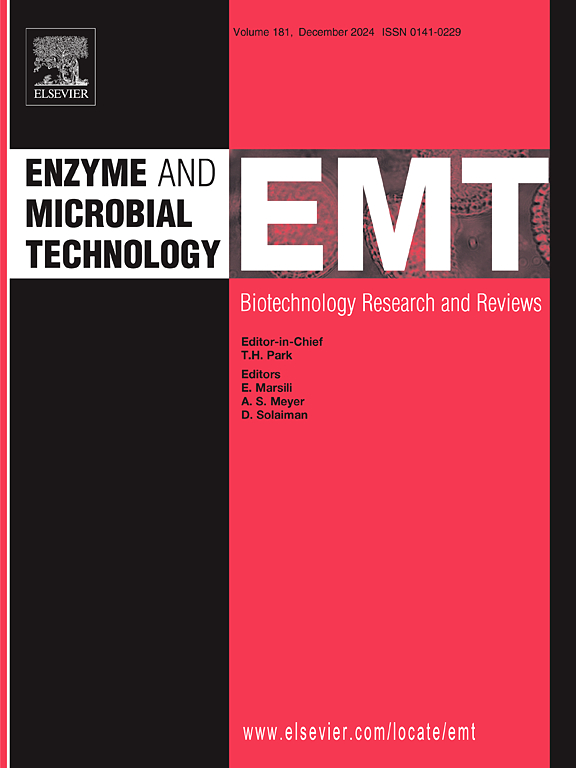Alcalase immobilization in iota-carrageenan-matrix hydrogel beads derived from the macroalga Solieria filiformis
IF 3.7
3区 生物学
Q2 BIOTECHNOLOGY & APPLIED MICROBIOLOGY
引用次数: 0
Abstract
This study aims to immobilize Bacillus licheniformis (Alcalase) protease in iota-carrageenan (ιCAR) matrix hydrogels via adsorption. CAR was extracted from macroalgae Solieria filiformis and used to produce hydrogels using Al3 + as the gelling agent. Subsequently, enzyme immobilization was performed at 25ºC, for 120 min using particles of ∼2.0 mm diameter, varying the medium pH values (7.0, 8.0, and 9.0). The immobilization at pH 8.0 resulted in the biocatalyst with the highest immobilization yield (100 %), expressed activity (88.9 %), and mass activity (10.4 U/g) for 1.0 mg/g of enzyme loading. When using particles with different diameters (1.0, 2.0, and 3.0 mm), the best results were obtained using 1.0 mm particles. This permitted a 100 % immobilization yield, 95.8 % expressed activity, and high mass activity (11.2 U/g). The lyophilized biocatalyst presented varying macro-pore diameters, ranging from 21 to 126 µm. The immobilized biocatalyst was 11 times more stable than the soluble enzyme at 60ºC and pH 8.0 and presented > 80 % retained activity in the pH range 6.0–9.0.
将钙化酶固定在由大型藻类丝状藻(Solieria filiformis)提取的藻胶基质水凝胶珠中
本研究旨在通过吸附法将地衣芽孢杆菌(Alcalase)蛋白酶固定在约-卡拉胶(ιCAR)基质水凝胶中。从大型藻类丝状Solieria filiformis中提取CAR,以Al3 +为胶凝剂制备水凝胶。随后,在25ºC下,使用直径为~ 2.0 mm的颗粒,改变培养基pH值(7.0,8.0和9.0),酶固定120 min。在pH 8.0的固定化条件下,当酶载量为1.0 mg/g时,固定化率最高(100 %),表达活性最高(88.9 %),质量活性最高(10.4 U/g)。当使用不同粒径的颗粒(1.0、2.0、3.0 mm)时,使用1.0 mm的颗粒效果最好。这使得固定化率为100% %,表达活性为95.8% %,质量活性高达11.2 U/g。冻干后的生物催化剂呈现不同的大孔径,从21到126 µm不等。固定化生物催化剂在60℃和pH 8.0下的稳定性是可溶性酶的11倍,在pH 6.0-9.0范围内保持了>; 80 %的活性。
本文章由计算机程序翻译,如有差异,请以英文原文为准。
求助全文
约1分钟内获得全文
求助全文
来源期刊

Enzyme and Microbial Technology
生物-生物工程与应用微生物
CiteScore
7.60
自引率
5.90%
发文量
142
审稿时长
38 days
期刊介绍:
Enzyme and Microbial Technology is an international, peer-reviewed journal publishing original research and reviews, of biotechnological significance and novelty, on basic and applied aspects of the science and technology of processes involving the use of enzymes, micro-organisms, animal cells and plant cells.
We especially encourage submissions on:
Biocatalysis and the use of Directed Evolution in Synthetic Biology and Biotechnology
Biotechnological Production of New Bioactive Molecules, Biomaterials, Biopharmaceuticals, and Biofuels
New Imaging Techniques and Biosensors, especially as applicable to Healthcare and Systems Biology
New Biotechnological Approaches in Genomics, Proteomics and Metabolomics
Metabolic Engineering, Biomolecular Engineering and Nanobiotechnology
Manuscripts which report isolation, purification, immobilization or utilization of organisms or enzymes which are already well-described in the literature are not suitable for publication in EMT, unless their primary purpose is to report significant new findings or approaches which are of broad biotechnological importance. Similarly, manuscripts which report optimization studies on well-established processes are inappropriate. EMT does not accept papers dealing with mathematical modeling unless they report significant, new experimental data.
 求助内容:
求助内容: 应助结果提醒方式:
应助结果提醒方式:


